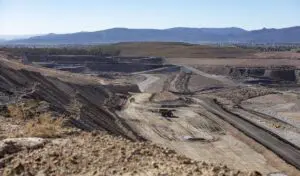
In a recent article on The Conversation, Queensland coal seam gas (CSG) researchers argued that the industry is progressing faster than the science, leading to concerns over fugitive emissions and impacts on water.
The Southern Cross University team found unexpectedly high levels of methane in the air near CSG wells. They concluded that we do not yet know enough about the impact of CSG mining. Their findings were attacked by industry interests as well as some politicians.
But the search for CSG is just the latest round in an ongoing contest for the ground beneath our feet. The underground pore space where CSG is found — known to geologists as “sedimentary basins” — is one of our most important resources.
While you may not have given them much thought, these basins underlie half of Australia, provide 90% of our primary energy through fossil fuels, and sustain most of our agriculture and rural populations with water.
Governments around Australia are making decisions about underground resources. Victoria, for example, recently released its Earth Resources Statement, calling for extensive reforms to the state’s resources regulation. It remains to be seen how the change in government will affect this.
In New South Wales, the recently established Office of Coal Seam Gas has been tasked with similar work.
These regulatory decisions will have impacts for generations. And the worrying thing is, we don’t yet know what all those impacts will be.

Rocky sponges
Gas and water reside in the sedimentary basins held in the “pore spaces” of rock, like water in a sponge.
Increasingly, sedimentary basins are being explored for new resources and services, such as CSG and shale gas, CO2 storage and geothermal energy.
For example, the federal industry minister, Ian Macfarlane, has said New South Wales gas supplies must be developed, mainly through extraction of coal-seam gas, or the state will face shortages.
Protesters, concerned about impacts on water resources and agricultural productivity, seek to block any such development.
At the same time our dependence on groundwater is increasing. These reserves also support a large fraction of Australia’s endangered riverine and rangeland ecosystems.

More and better science
Sedimentary basins are a public good.
The search for new resources like unconventional gas marks a new stage in the contest for the subsurface. The increasingly heated rhetoric about environmental risks associated with coal-seam gas developments and geological CO2 storage illustrates the need for new approaches to the management of sedimentary basins worldwide.
Australian Chief Scientist Ian Chubb has responded to a report on unconventional gas delivered to the Prime Minister’s Science Engineering and Innovation Council, saying we need to support research into “the geological and geophysical aspects of prospective sedimentary basins” and “the surface and groundwater dynamics of prospective sedimentary basins”.
In other words, we need to build a better understanding of how Australia’s sedimentary basins work and how new technologies and extractive processes such as CSG may affect precious water resources. And we need to do this now.
This urgent need for a beefed-up science and monitoring capacity should drive a new research agenda, providing trusted, credible information and analysis of sedimentary basins, as well as the opportunities and risks posed by new uses of their resources.
This agenda needs to be shared and supported by industries, governments, communities and the research sector. The Melbourne Energy Institute is advancing a Sedimentary Basins Management Initiative to meet this need.
Building trust
Communities need access to robust research findings they can trust. Governments need to make evidence-based decisions in a timely manner. Companies require leading-edge data.
Politicians and public servants must work across parties and jurisdictions to enact policy decisions on basins that cross state and territory lines.
We will need geoscience for comprehensive and independent monitoring under (groundwater systems) and above ground (fugitive emissions of methane). This will provide baseline data against which future impacts can be detected and managed, a crucial need highlighted by the Southern Cross University researchers, who note in their paper the need to quantify greenhouse gas emissions “before and after production commences”.
We need the legal and regulatory expertise to develop management regimes that cross different resources and jurisdictions.
We need economic expertise to assess the costs and benefits of multiple uses of the pore space.
Perhaps most importantly we need to apply social sciences to ensure that community aspirations are met and that a “social licence” is fully integrated into basin management decisions.
![]() Authors: Sarah Bice, Mike Sandiford, and Will Howard.
Authors: Sarah Bice, Mike Sandiford, and Will Howard.
Source: The Conversation. Reproduced with permission.









